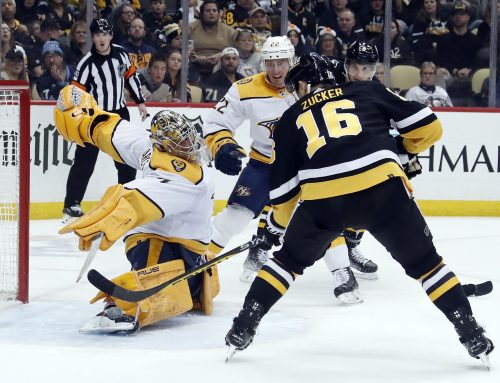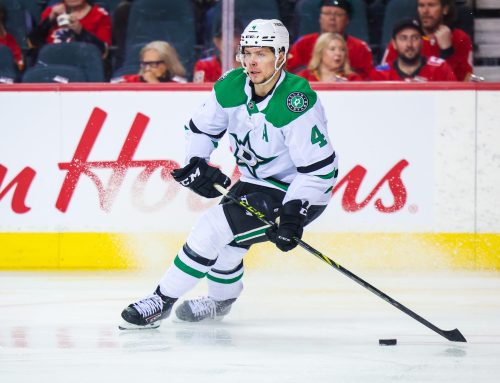
This week's Capped begins a series looking into how to project player salaries.
****
A happy new year to everyone. Hopefully you all enjoyed the break, but now it is back to work, and we don’t miss a week here either. With 2018 upon us, I looked back through the past year of the Capped column, and feel that some of the weekly pieces may have gotten a little off topic, away from the salary and value focus. Now don’t go thinking that all of the fantasy related thoughts and analysis is going to go away, but there are a few specific salary topics that I will be sprinkling in more often.
Outlining the Project
To start off, we are going to outline how to begin to project player salaries. In cap leagues, one of the toughest things to do is analyze the value of a player on an expiring contract. Everyone has their own way to value players versus their current contracts, whether it be dividing points per dollar, by groupings of each million, or spreadsheets breaking down each stat per dollar. However, when it comes to projecting player salaries, the best we really have is our own guesses, usually based off comparisons, and preconceived notions of different players. Over the last few months I have started to compile a bit of an input software, modeling contract projections in an unbiased way. The project is still in its infancy, but it has provided a very good thought project thus far. I have learned quite a bit from it, and at this point have it projecting skater cap hits within about 10% and contract length within 16% (or an average of one-year deviance). Ideally, it can be optimized down to about five percent for each number, but the base thought train is the biggest part, the second half of this is just tinkering with numbers.
The project raised some good questions though, mainly revolving around “what actually influences how much a player makes?”. The base of it comes down to how much value a player can provide above replacement level. Comparing the scoring, to the defence, to leadership and toughness, what has the biggest pull, and with what kind of ratios? Additionally, how do other factors affect the contract, such as age, family, and even the tax rate for each city? Let’s just say it’s a work in progress, and in the meantime, we’ll try to get you some tips for simplifying the process.
****
The Process
The biggest thing to take away this week, is where to get the baseline for a projection. A projection has to start somewhere, and if it is an unbiased projection we are seeking, it can’t be comparison based (the eye test), it has to be done statistically. Where does that lead us for a player contract? Well it leads right to the salary cap. Each player on a team uses up a certain percentage of a team’s total salary space, with the better players getting a larger chunk of the pie. As a result, by factoring each player based on what they bring to the table, we can split the pie up equally, getting a much clearer picture of what each player deserves.
What we have to remember, is that this is an inexact science. There will always be other variables since no two players are the same. Someone may want to come back and play for their hometown, whereas another player may want to go to the Stanley Cup favourite. Certain players may look for more job security with a longer-term deal, whereas others see the opportunity to strike it rich with their next contract, usually in unrestricted free agency. These smaller deviations can be attempted to be taken into account, but the meat of the contract prediction should come from the pure numbers. These include scoring, previous contracts, age, team tax rates, health (measured in games played), etc. Once a shape is formed through these numbers, the edges can be refined with the specifics of the situation of each individual player.
****
Simplification
It doesn’t make sense for most fantasy league participants to try going through and accurately predicting player salaries for future years. However, as an example, when we are looking to trade for an impending free agent, the player’s future contract is taken into account. If we think that they are going to get a big raise and become overpaid then the player loses value, and you have to adjust your trade plan accordingly. In our heads, we usually do quick checks, comparing player X to player Y. Let’s say that players X & Y are similar players, but player X scored a handful more goals last season and also plays on the penalty kill. If player X is the one we are trying to trade for, and player Y has recently signed a new contract, we then have the mental note that player X’s future contract should be a little more than player Y’s and we can evaluate our trade options accordingly.
I have found, that through the initial stages of the modeling project, position, and then age (in that order) are the two key factors to finishing with a more accurate result. They have shown to be more valuable than points, draft round, free agency status, and any other variable I have included to this point.
Putting this into perspective, if you are considering a trade for Mark Stone, an RFA in July of 2018, you would start with a projection by looking at other 25/26-year-old wingers who recently signed new contracts, such as Nino Niederreiter, Artemi Panarin, and Ondrej Palat. Palat and Niederreiter have similar contracts to use as a base, but Panarin scores closer to Stone’s pace. Considering Panarin’s split career in Russia thus far, he didn’t warrant or need a long-term contract. Putting those together, we end up with a $6 million dollar estimate from Panarin, a five-year contract from Palat and Niederreiter. Then we take into account some of the secondary variances, such as the fact that Stone has a little bit more of a track record than the others, in addition to a rising cap, which would bump the numbers up a little bit, making the projection something around $6.5 million for six years. Voila, a simple baseline to be used for planning purposes.
****
Progress is starting to pay off. Yesterday I plugged Jonathan Marchessault into the spreadsheet, and it has him pegged at about $4.867 million for a five-year contract. That is pretty close to what he ended up signing for on Wednesday, landing himself a pretty $5.0 million each of the next six years.
****
That caps off another Thursday. Thanks for reading! Next week I am hoping to dive right in to a few deeper projections, explaining a little bit more about what to look for, so stay tuned.
In the meantime, I would love to hear if anyone else has tried to model contracts before, or if you use other methods to approximate what players will be making, for the sake of future planning in cap league. Let me know in the comments.
As always, you can find me on twitter @alexdmaclean where I post some of my other smaller musings that don’t make it into the articles.





 FLA
FLA CHI
CHI NYR
NYR PIT
PIT L.A
L.A COL
COL CAR
CAR UTA
UTA SEA
SEA
 NYI
NYI TOR
TOR N.J
N.J MTL
MTL
